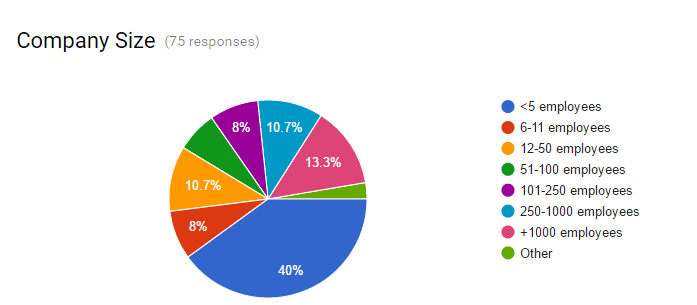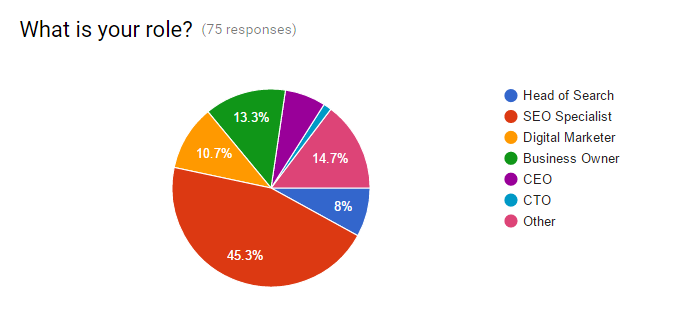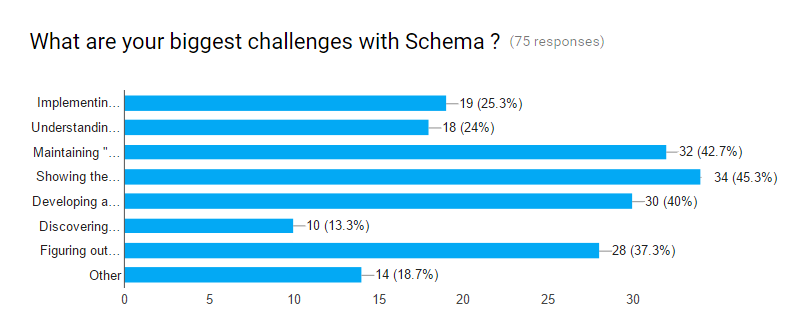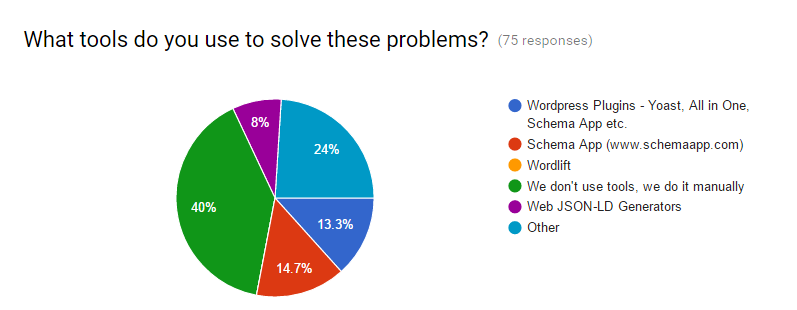The State of Schema.org: What are the biggest challenges surrounding Schema markup?
Using Schema.org markup, a form of structured data which helps search engines to interpret your webpages, is widely agreed to be beneficial from an SEO standpoint.
While it may not correlate directly to an increase in ranking, using Schema.org markup allows search engines to pull through rich snippets and rich data like images, reviews and opening hours, making your site appear more attractive on the SERP and thereby increasing click-through.
Schema.org markup is also becoming increasingly important in the age of voice search, acting as a signpost that points digital assistants towards the information that will correctly answer a user’s voice query. Voice queries depend heavily on implied context, and Schema markup can help give that context to an otherwise ambiguous page of text.
But while the advantages of using Schema.org seem obvious enough on paper, actually implementing it can be much more challenging. As a result, a startlingly small minority of website owners make use of Schema.org.
The figures vary as to exactly how many; Schema.org’s website claims that “over 10 million websites” use Schema.org markup, which translates into less than one percent of all websites; an investigation by ACM Queue put the figure at 31.3%, while a study by Bing and Catalyst found that just 17% of marketers use Schema.org markup.
Either way, even the highest estimate of Schema.org adoption still comes in at less than a third of websites.
With Schema.org being a well-known advanced search technique with well-established benefits, what is holding SEOs and website owners back from implementing it?
The state of Schema markup
Schema App – a provider of tools to help digital marketers use Schema markup – recently ran a survey which sheds some light on this question. The study, ‘The State of Schema Markup’, surveyed users of Schema.org markup on the size and type of their business, how frequently they maintained their markup, the challenges they experienced in using Schema.org, and any tools they used to tackle these problems.
It’s worth noting that the survey results were drawn from a fairly small sample of only 75 respondents, which limits our ability to generalize them too widely, but they nevertheless give some interesting insights into the use of Schema markup among marketers.
Perhaps surprisingly, respondents from the smallest companies – those with five or fewer employees – made up the largest percentage of Schema.org users, with two-fifths of respondents reporting that they carry out Schema markup for companies of just five employees or fewer.
It’s hard to say exactly why this is – maybe smaller, more agile companies are better at keeping up to date with advanced search tactics; or maybe they will do whatever it takes to stand out on the SERP in order to increase their competitivity with larger organizations.
The second-largest group, conversely, was made up of companies with more than 1,000 employees, although this group still only amounted to 13% of respondents.
A third of respondents to the survey came from digital marketing agencies, while 28% said they came from small or medium businesses. Sixteen percent of respondents were from enterprise organizations, while a fraction under ten percent were from start-up companies.
The job titles of respondents to the State of Schema Markup survey revealed that it’s not just SEOs who are doing Schema markup. While more than half of respondents to the survey were search specialists (either SEO specialists – 45% – or Heads of Search – 8%), digital marketers, business owners, CTOs and even CEOs were among the remaining 47%.
Another interesting finding was the frequency at which respondents update their Schema markup. Judging by the frequency of posts to the official Schema.org blog, updates to Schema.org are fairly sporadic, sometimes coming two or three months apart, other times going six or seven months without an update.
Google updates like the recent introduction of rich results for podcasts to the SERP can also give marketers an incentive to add new coding, as can regular site maintenance. However, I was surprised that close to a fifth of respondents (19%) said that they update their Schema markup every day.
A further 31% of respondents update their markup weekly, while the largest proportion (39%) update their markup once a month. An unstated percentage (which visually looks to be about 8%) say they work on their markup once only.
The biggest challenges surrounding Schema markup
Anyone who has tried to tackle Schema.org markup (or write a blog post about it), particularly without much of an understanding of code, knows that implementing it can be easier said than done. Even tools like Google’s Structured Data Markup Helper have their limitations, making it necessary to understand markup if you want to fill in the gaps.
This reality was reflected in the comments from marketers who took the Schema App survey. One respondent wrote,
“When I first learned about the existence of schema, I was so confused on how to implement it. I am not a developer. After trying many online generator tools and finding them unsatisfactory, I turned to my programmer hoping he could take over this task for me. He explained it was a different code altogether than what he writes. I felt overwhelmed when he confided he had no idea at all how to do it, even after spending a little time looking at it.”
Another respondent observed that “The examples given on schema.org were not clear and sometimes it seemed they did not follow even their own rules.” A third described Schema.org markup as feeling “a bit like witchcraft”.
Although a number of search blogs like Moz, WordStream, Yoast and indeed yours truly have set out to write guides on how to use Schema.org markup, there are still a limited number of resources available to help with this process; and comments on the State of Schema Markup survey reveal that many of those which do exist are flawed.
“Worse is that some of the schema is supported … but not in the Structured Data Testing Tool,” one respondent wrote.
Another wrote that, “It’s still very much a trial and error process for me as I find that some of the guides out there, when put through Google’s tool, don’t actually parse correctly. Very frustrating…”
Overall, the most widely agreed-upon problem experienced by survey respondents was “Showing the value of doing schema markup – reporting the impact and results” (reported by 45%). Close behind this was “Maintaining ‘health’ of Schema markup when Google makes changes” (reported by 42%).
Two-fifths of respondents cited difficulties in developing a strategy around what to mark up with Schema, while 37% struggled with how to implement Schema markup at scale – few solutions exist for the bulk markup of webpages, which can create huge challenges for companies with large websites, on top of the difficulties that we’ve covered already.
Although it ranked near the bottom of the list of concerns cited by survey respondents, close to a quarter (24%) of respondents still cited “Understanding Schema markup vocabulary” as one of their biggest obstacles to carrying out Schema markup.
And as we’ve seen, this is coming from a group of marketers of whom the majority use Schema markup habitually – no wonder the wider marketing community is having trouble getting on board with Schema.org.
Tools for tackling Schema markup
Finally, respondents were asked what tools they use to solve the problems they experience with Schema markup, from a range of options including WordPress plugins, Wordlift, Web JSON-LD generators, Schema App’s own tool, or no tools at all.
The last of these options was the most common by far, with 40% of respondents asserting that they do all of their Schema markup manually. I can’t help but notice that this corresponds exactly to the percentage of respondents from small companies with 5 or fewer employees – I wonder if there could be some correlation there.
Fifteen percent of respondents said they make use of Schema App’s own tool, while 13% use WordPress plugins. Another 8% use Web JSON-LD generators, while 24% use tools other than those listed in the survey.
One business owner wrote that they tend to solicit help on Schema markup from online communities: “I ask for help in online communities and usually get answers. The definitions and examples have become better over time in both schema.org and Google.”
A Head of Search at an enterprise company wrote that they use “Internally developed tools and markup checkers that were developed for our specific needs.”
For those two-fifths of respondents who opt to do their Schema markup without the aid of automated tools, this could be due to a lack of technical resources, a lack of confidence in automated solutions, or perhaps because they simply don’t know that these tools exist.
But we can clearly see that there is a demand in the marketing and search community for more accurate and helpful resources surrounding Schema.org, whether these be in the form of web generators, apps, or how-to guides and tutorials.
Perhaps Schema.org needs to take the initiative to make its markup language more accessible by creating these, or perhaps they will be created by an interested third party. Either way, without them, we are unlikely to see the dial shift much on the uptake of Schema markup among marketers and SEOs, no matter how useful it is.
source https://searchenginewatch.com/2017/04/18/the-state-of-schema-org-what-are-the-biggest-challenges-surrounding-schema-markup/




